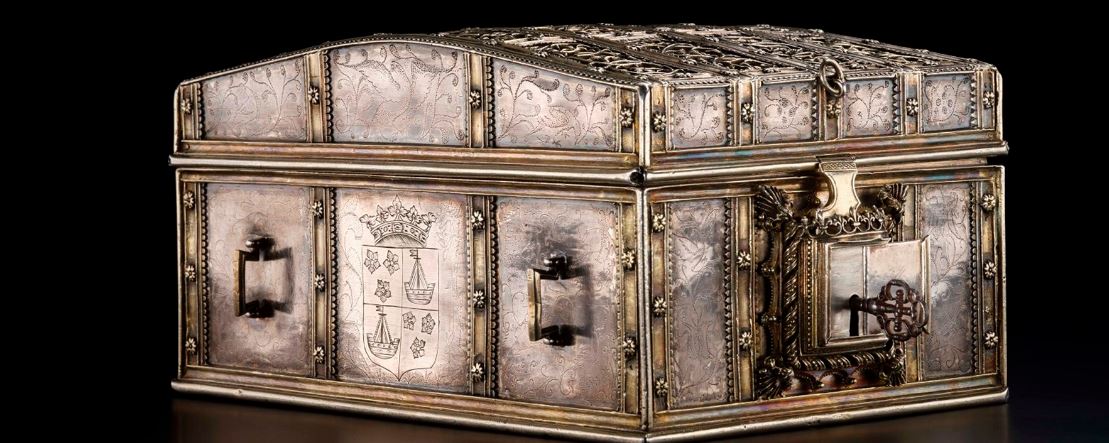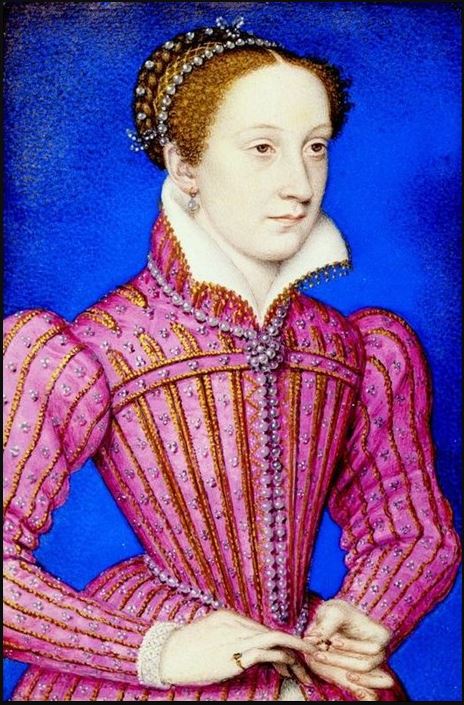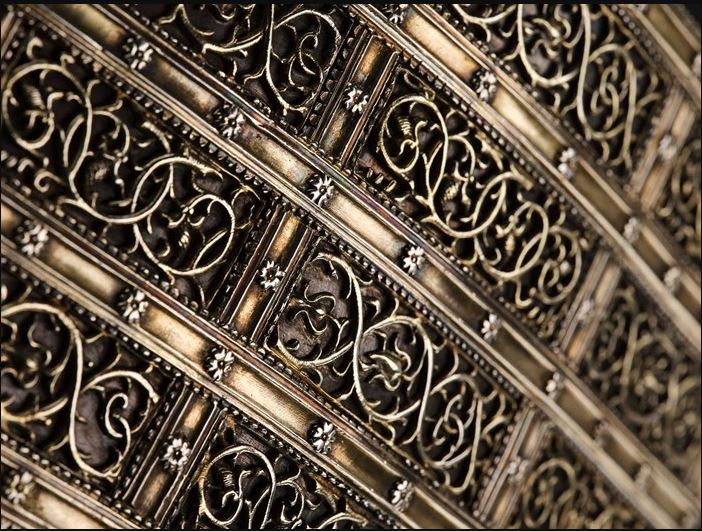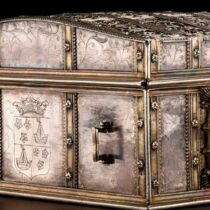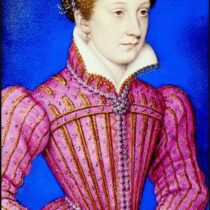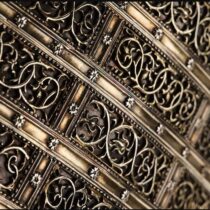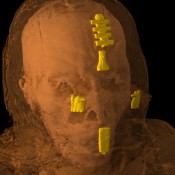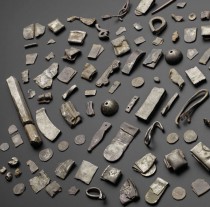The silver casket believed to have been owned by Mary, Queen of Scots, is on display in the National Museums Scotland’s Hawthornden Court. It will be shown through August 1, 2022, when it will be moved to its permanent location in the Kingdom of the Scots gallery alongside other objects from the Museum’s collection associated with Mary.
Made in Paris at the end of the fifteenth or early sixteenth century, the survival of this casket is particularly significant. In the late 1600s, the French King Louis XIV ordered valuable objects like this to be melted down to pay for his armies. The casket escaped this fate because it had probably left France in the mid-1500s.
There are no other comparably fine French caskets known to exist from this period, making the Mary, Queen of Scots Casket particularly rare. It is likely that the belief in its association with Mary has kept it preserved for the past 450 years.
Crafting the casket
This ornate object was made by an extremely skilled goldsmith. We can tell that the goldsmith was in Paris from two maker’s marks stamped into its external underside panel. They have a crowned fleur-de-lis identifying the casket as Parisian, which sits above two symbols for the specific goldsmith, a fire steel or strike-a-light with a small Greek-type cross beneath it. After 1506, the French king Louis XII ordered the Parisian goldsmiths to start using a new type of mark, which means the casket must have been made by this time.
The decoration on the lid is known as ‘strapwork’, with alternating wide bands of three-dimensional scrolling leaves and flowers, and narrower, flat bands of flowerlets. The decoration of the sides is very different, with pinpricked flowers, birds, a rabbit, and a running stag and dog. This work may have been done later, and further scientific work will attempt to see if it replaced a previous design.
On one side is an engraving of the arms of the Dukes of Hamilton, with their distinctive symbol of the birlinn, or galley, in the second and third quarters. Three cinquefoils appear in the first and fourth quarters. When magnified, you can see that these arms have replaced something that has been erased. According to the provenance note, these were the arms of the Marquis of Douglas, and before that, of Mary, Queen of Scots.
The Mary, Queen of Scots connection
For over 300 years, a handwritten letter telling the casket’s history has been stored within it. This note records that the casket was bought by Anne, Duchess of Hamilton, having been told by its previous owner, Mary, Marchioness of Douglas, that the casket had belonged to Mary, Queen of Scots. It is this long-attested association with one of Scotland’s most famous historical figures that gives the casket its special significance.
Handwriting analysis has shown that the letter was written by David Crawford, secretary to Duchess Anne, before the duchess’s death in 1716. Crawford wrote that “the Duchess of Hamilton being told that by my Lady Marquis that the said box did once belong to the Queen Her Grace bought the same from the goldsmith” after the marchioness’s death in 1674. The Marchioness of Douglas had left it to her younger son, James, who promptly sold it. On hearing this, the Duchess of Hamilton, who had married the marchioness’s older son William, retrieved it from the goldsmith.
The note shows, therefore, that the casket has been believed to have been owned by Mary since at least the mid-1600s. Ever since, it has been carefully preserved by the Dukes of Hamilton who have treasured it as a relic of the queen.
Over the centuries, its association with Mary, the belief that she owned, touched, and used this casket, has given it a reverential quality. It is a physical connection to the long dead queen, an enduring reminder of Queen Mary’s dramatic life.
The ‘Casket Letters’
The casket is also associated with a momentous period in Mary’s life. The provenance note records that it “was the box that carried letters and tokens by messengers to and again between Queen Mary of Scotland and the Earl of Bothwell”. Bothwell was Mary’s third husband, whom she married after the murder of her second husband Henry, Lord Darnley, in 1567. The note demonstrates the historical belief that this casket contained the infamous ‘Casket Letters’.
Shortly after Mary was overthrown by the rebellious Confederate Lords in June 1567, a silver-gilt casket was seized by the Earl of Morton from one of Bothwell’s servants. He brought it before the Scottish Privy Council in Edinburgh and forced its lock to examine its contents. There is no record from then of what it contained.
However, following Mary’s flight to England in 1568, the casket was produced at a hearing against Mary at Westminster, where it was found to contain letters alleged to be between Mary and Bothwell, and some love sonnets.
This hearing had been ordered by Elizabeth I to investigate accusations against Mary of conspiring with Bothwell to murder Lord Darnley. The ‘Casket Letters’ were used as evidence of Mary’s guilt, and of an adulterous relationship with Bothwell while Darnley was alive. They were revealed by Mary’s half-brother James, Earl of Moray, whose own interests would prosper if Mary was found guilty. Although nothing was ever proven, Mary remained in English captivity until her execution in 1587, nearly nineteen years later.
The Dukes of Hamilton have believed for at least 340 years that the casket in their possession was the ‘Letters’ casket, as did the Marchioness of Douglas before them. It is this historical belief in the casket playing such a prominent role in Mary’s downfall that gives it an extra layer of meaning, connecting those who see it today to those disastrous moments in Mary’s life over 450 years ago.
It cannot be categorically proven or unproven that the Mary, Queen of Scots Casket belonged to Mary, or that it was the ‘Letters’ Casket. Either way, it can certainly be said that it has been believed for over 360 years to have been hers, and to have contained letters between Mary and Bothwell.
Relic of an iconic queen
Elizabeth famously called her cousin Mary, Queen of Scots, ‘the daughter of debate’. Mary was a controversial figure in her own lifetime, who stirred up fierce loyalty in her supporters and equally impassioned opposition from her enemies. Mary continues to inspire similarly strong reactions today. Myth and mystery continue to obscure the reality of who she was, and what she was supposed to have done, and the authenticity of the Casket Letters remains hotly debated.
Films, plays, operas, countless novels and whodunnits recount the drama of her life. Items associated with her, or made subsequently in her memory, are numerous. The Mary, Queen of Scots Casket, however, is a particularly magnificent example of an object through which Mary has been commemorated.
It tells us of a majestic Mary, Queen of Scots, who was also briefly Queen of France (1559-1560). She was a queen almost from birth, educated to rule and furnished with the trappings of a Renaissance monarch who bought, was given, and inherited precious jewels and objects like the casket. The casket reveals a different Mary to the one dressed dolefully in black in posthumous portraits: a vivacious, youthful, pearl and silk-adorned Renaissance Queen.
